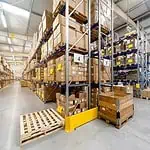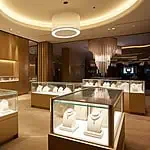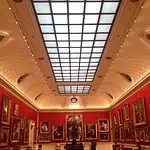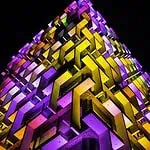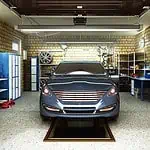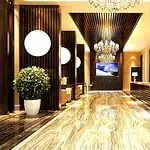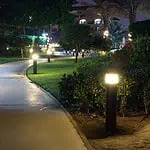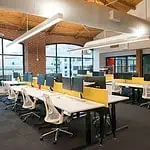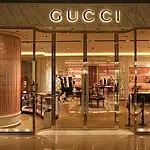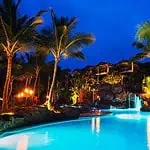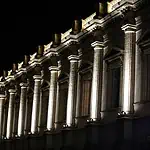Want to make your commercial space more attractive to grab customers’ attention? If yes, you are not alone and you are just at the right place for the best solution. Furthermore, proper lighting enhances your products’ beauty or service-receiving experience. And thus builds your brand reputation!
Commercial lights are more robust and brighter than residential lights. However, every commercial space doesn’t have the same lighting needs. Some areas require warm lighting, others cool; some need high brightness/voltage, while others work on lower ratings. Besides, ceiling height, IP rating, beam angle, etc., are other facts for selecting commercial lights.
Confused knowing about all these facts on commercial lighting? No worries! In this comprehensive expert guide, I will assist you in choosing the best fixture for your space. It doesn’t matter what kind of commercial establishment you have; this guide will definitely help you. So, let’s dig in-.
What is Commercial Lighting?
Commercial lighting refers to the fixtures used for lighting business and retail purposes. This includes- offices, restaurants, shopping malls, hotels, and more. The fixtures used in these areas face heavy impacts daily. For instance, the lights of gas stations and auto repair shops regularly deal with dust, oils, chemicals, and other ingress. Again, these areas put the fixture at risk of being hit or colliding. So, to protect the lights from these unexpected situations, commercial lighting has a high resistance level and durability.
Earlier, incandescent or fluorescent fixtures were more in use for commercial lighting. But with the advancement of technology, LED lights are gaining more popularity. There are countless reasons in favor of this.
The electricity bill is a major consideration as commercial lights are kept on for long hours. In this case, business owners consider minimizing costs by choosing LED lights over other options. These fixtures are highly energy efficient and have a wide range of advanced features to uplift your commercial ambiance.
Types of Commercial Lighting
Different variants of lighting are available for commercial lighting. Analyzing these types, I have categorized commercial lights into three major classes; these are as follows-
Incandescent lighting
Incandescent lights are the most primitive bulbs with gas filling. These lights are popularly known as halogen lights. The glowing filament in the middle of these bulbs gives a warm illumination to the space. Earlier, these lights were very common in the commercial lighting sector. But many countries have banned incandescent lights due to their negative impact on the environment. In addition, they consume a huge amount of energy that increases your maintenance cost. For these reasons, incandescent bulbs are now rarely used in commercial lighting.
Fluorescent lighting
Fluorescent lights are more energy efficient than incandescent lights. They are a popular option for offices, schools, and garages. You will also find these lights in old mills and factories. But the mercury vapor emitted through these fixtures harms the environment. Considering these factors, some countries have already banned it. However, these lights are still used in the US for certain commercial applications.
LED Lighting
LED stands for ‘Light Emitting Diodes.’ Compared to fluorescent lighting, LEDs are much more energy-efficient. They consume almost 85% less energy and have more advanced features. You will also get advanced lighting options using these fixtures in commercial areas. Besides, LED fixtures have endless designs. Here are some widely used LED lightings-
- Floodlights: Floodlights are widely used in commercial areas like- hotels, restaurants, resorts, shopping malls, and museums. You can use them as accent lighting for commercial building facades. The main purpose of this lighting is to bring the texture of infrastructures or to highlight special elements. For instance, if you have an aesthetic stone wall in your restaurant, you can add these lights to highlight the textures.
- Uplights and Downlights: Depending on the lighting direction, you can classify commercial lights as uplights and downlights. Uplights lights are mostly used for accent lighting. You will find them on the facade of commercial buildings highlighting the architectural structures. These lights are also found in lighting swimming pools and gardens. In contrast, downlights are usual fixtures used for general lighting. Flush lights and semi-flush lights are all under this category. To know more about downlights, check this- What are Downlights and How to Choose One?
- Spotlights: You will find spotlights in every category of commercial areas. They are found everywhere, whether it’s a shopping mall, office, or factory. These small directional lightings work excellently to illuminate the targeted object. However, many of you may need clarification on floodlights, spotlights, and downlights. If that’s the case, you can check the differences- What is the Difference Between Floodlight, Spotlight, and Downlight?
- Path Lights: The pathways of commercial areas require visibility at night to walk. Besides, illuminating the walking areas to avoid unexpected accidents is also a matter of safety. LED bollard lights are an amazing option for path lighting. You will find them on the driveways, garages, or in the walkways of hotels, resorts, or other commercial buildings.
- Tube Lights: You will find long tubular light fixtures in commercial spaces. They are an excellent replacement for fluorescent lighting. The slim fit style of these lights makes them a suitable choice for commercial areas. They are widely used in schools, malls, mills, factories, garages, etc.
- LED Strip: LED strips are becoming famous in residential and commercial lighting. These strips are super flexible and easy to size and install. You can use them as general or accent lighting for your showroom, restaurant, hotel, etc. Besides, you can get customization options for lighting output that can assist you in getting the desired commercial ambiance.
- LED Neon Flex: The bright signage outside the shops, cafes, hotels, and malls is an excellent example of LED neon flex. These lights are an ideal replacement for traditional glass neon lights. Regarding branding, these glowing lights are excellent for building your reputation. To know more about their uses, read this- Where To Use LED Neon Flex?
- Recessed Lights: Recessed lights are built-in lights that give clean and sleek lighting. You will find them in the ceiling of hotels, offices, events, halls, malls, etc. These small lights are also known as pot lights. When it comes to stair lighting for commercial purposes, these lights are an excellent option. However, an IC rating is essential when choosing recessed lighting with insulated ceilings.
- Decorative Lights: Chandeliers, lantern lights, pendant lights, and other designer fixtures that you see in commercial areas are all LED lighting. These are used to enhance the appearance of the space to increase public engagement.
- Tri-proof Lights: When choosing lights for commercial areas like factories, manufacturing lines, or mills, going for robust fixtures is a must. Tri-proof lights are water, dust, and corrosion-resistant. You can use them in areas with chemical or toxic elements and heavy moisture content. They are also explosion resistant. To learn more about these lightings, check this- What is Tri-Proof Light and How to Choose?
- Emergency Lights: What if your office or other commercial buildings have a sudden power cut, and you hear fire alarms? Rushing to find a safe place in the dark is not easy. In such situations, emergency lights are a lifesaver. These lights glow immediately when the power cuts off and help you navigate safely. Thus, they ensure a safe exit from the building in urgent situations. For more, read this- Why Is Emergency Lighting Essential?
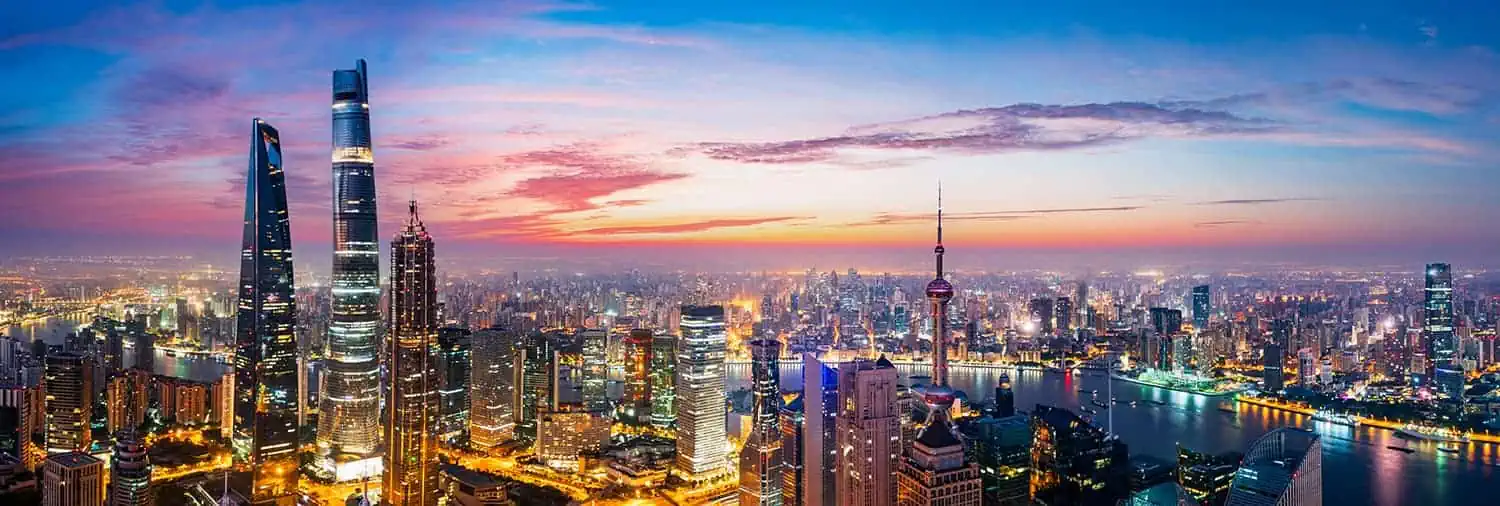
Application Of Commercial Lights
The use of commercial-grade lights is seen in every commercial sector. However, the most common application of these lights are as follows-
- Office: Commercial lights are used in the working space, conference room, and other common office areas. In choosing lights for the office, comfort for employees is given the most priority. To learn more about office lighting, check this article- Office Lighting: The Definitive Guide.
- Hotel & Restaurant: Lighting plays a crucial role in hotels and restaurants. Besides providing visibility, lights enhance the ambiance of the restaurant/hotel encouraging people to take their services. Different types of decorative lighting take restaurants’ outlooks to the next level. Thus, lighting is a part of restaurants’ branding and marketing strategy. To get innovative ideas to light your restaurant, check this- Top 31 Restaurant Lighting Ideas. And if you are planning to light your hotel, this article will guide you- Hotel Lighting: The Definitive Guide.
- Shopping Malls & Retail Stores: Commercial lights are used in shopping malls and retail stores to showcase the products. Spotlights, LED strips, recessed lights, and track lights are the popular light variants used in retail stores. Check this for a complete retail lighting guideline- Retail Lighting: Definitive Guide.
- Theatre & Museum: Theatre and museum have commercial-grade lights to exhibit the shows and masterpieces. Angular spotlights are popular in this sector to highlight specific zones. Besides, track lights are also widely used to highlight artistic sections of the museum.
- Garage: Whether it’s a professional garage or a parking zone, commercial-grade lighting is essential for these zones. In the garage, automobiles are given servicing. The light fixtures used in this place go through water splashes and have a higher impact risk. So, commercial lighting with higher IP and IK ratings is suitable here. For more information, you can check Garage Lighting: The Definitive Guide.
- Gym & Yoga Studio: Gym and Yoga studios are commercial areas associated with health and fitness. In these zones, comfortable fixtures are installed to provide the customer with a suitable environment to do their workouts. These guides will help you to choose the best lighting for your gym and yoga studio- LED Gym Lighting: The Definitive Guide & How to Choose Lights for Yoga Studio?
- Barber Shop, Salon & Spa: Correct light color temperature and comfort are major considerations in lighting commercial areas like barbers, salons, and spas. They have different lighting requirements. For example, the hair-cutting section demands cool lighting, whereas the spa or massage section services are enjoyed best in warm lighting. Besides, the CRI rating of the light fixtures is an essential consideration regarding hair color and grooming services. This is the guide to help you bring the best commercial lighting for a barber shop- How To Choose Lighting For A Barber Shop?
- Gas Station & Auto-Repair Shops: High-resistant light fixtures are ideal for gas stations and auto-repair shops. The lights face heavy moisture content, high temperature, dust, dirt, and other adverse situations in these areas. Besides, the fixtures also deal with toxic chemicals. In this situation, tri-proof light fixtures with safety features are used.
- Outdoor Lighting: Besides indoor lighting, commercial lights are also used in outdoor lighting of shopping malls, restaurants, halls, theaters, etc. Flood lights, LED neon signage, and LED strips are the most popular variants of commercial outdoor lighting.
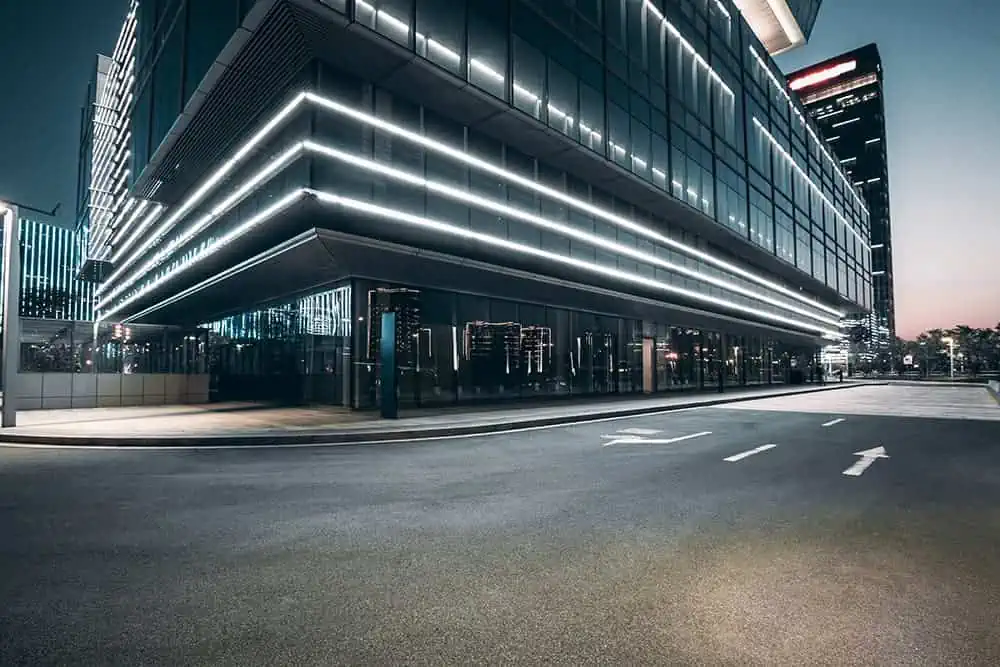
Advantage Of Commercial Lighting
Having good commercial lighting brings a bunch of advantages to your business. These include-
- Enhanced visibility and safety: Commercial places gather employees, customers, visitors, and people of all classes. So, ensuring proper visibility and safety is a must, especially at night. Along with clients, your staff will feel safer arriving at work and leaving at night if the parking lot, pathways, and entrances are well-lit. However, in commercial spaces, lights are turned on all day to maintain the same ambiance all day long.
- Increased productivity: Lighting has a great impact on work productivity. For instance, installing cool white commercial lighting in workstations, like offices, keeps the employees energetic and active. This eventually brings better outcomes for the business.
- Competitive advantage for your business: Proper and attractive commercial lighting can give you a competitive advantage. But how? When you have a well-lit space, the customers feel more attracted to take your services. It also enhances your company’s reputation and image.
- Opportunity to own your business branding: You must be amazed to hear that lighting can allow you to own your business branding! For instance, the glowing logos you see outside the shop or mall are neon lights. The vibrant color and high brightness provide visibility to the customer from a long distance. You can use the color of lighting, greeting cards, price tags, etc., to match your brand logos. Besides, installing customized lighting in your commercial space also gives you branding opportunities.
- Inviting Entryway & Easy Exploration for Your Customers: You can encourage the customers to visit your outlet, restaurant, or services, having excellent exterior lighting. Besides, having a glass wall will give the customer an overview of the interior lighting. You can add design light fixtures to your space to grab customers’ attention. And eventually, they will explore your services, helping you grow the business.
- Smart lighting integration: Smart lighting options are gaining popularity these days. You can install motion sensor lights on the stairs and entrances of commercial buildings. It helps you build a good impression and gives the customer a high-tech experience. Using these lights in your commercial spaces can help you increase your brand worth.
Disadvantage Of Commercial Lighting
Besides the advantages, commercial lighting has some drawbacks worth mentioning. These are as follows-
- High energy consumption: Commercial lightings, like incandescent and fluorescent bulbs, consume more electricity. As commercial spaces require 24/7 lighting facilities, it can be heavy on electricity bills. However, there are energy-efficient options like LED lights. They consume minimal energy saving your overall cost.
- Maintenance and replacement costs: Lights used in commercial places go through several unfavorable situations like- dust, water, chemicals, collision, hits, and more. You need to be more careful about maintaining light fixtures to keep them working in such a challenging environment. Yet, you can minimize the maintenance and replacement cost by purchasing full-quality fixtures with higher IP and IK ratings.
- Limited lifespan: Commercial lighting variants have a shorter life span. So, installing these lights will require frequent replacement. Besides, they are not energy-efficient. This makes the maintenance and overall cost too high. But LED lights are a great replacement for these bulbs for commercial lighting. Here is a lifespan comparison between incandescent, fluorescent, and LED lights-
| Lifespan Of Different Commercial Lightings | |||
| Type Of Light | Incandescent Light | Fluorescent Light | LED Light |
| Hours | 1,000 hours | 15,000 to 20,000 hours | 50,000 to 100,000 hours |
So, if you keep a commercial light on for 10 hours daily, incandescent light can last only 100 days. In contrast, LED lights can last for 14 years or more!
- Lack of flexibility: Commercial lights are usually installed as permanent lighting. Some lights are installed in built-in methods or challenging areas that don’t facilitate flexibility. Apart from these, features like- dimming, color changing, etc. options are rare in commercial lighting.
- Heat generation: Incandescent or halogen bulbs, common choices for business lighting, generate much heat. Customers or staff may become uncomfortable, especially in small, poorly ventilated environments. Additionally, it puts more strain on air conditioning units, resulting in increased energy expenses.
- Initial cost: Commercial lightings have a robust structure and better resistance level. These features make them more expensive than regular lighting. Apart from this, the installation cost is also higher for such lighting. You will need a professional electrician to ensure proper wiring of the space. And all these factors increase the initial cost of lighting commercial areas.
- Environmental impact: Some traditional commercial lighting has a negative impact on the environment. They produce greenhouse gasses that cause global warming. Again, toxic gasses produced from incandescent and fluorescent bulbs also harm the atmosphere. However, with LED lighting, you need not worry about these factors as they are energy environment-friendly. Check this article to learn the advantages and disadvantages of LED lighting- Advantages and Disadvantages of LED Lighting: A Guide.
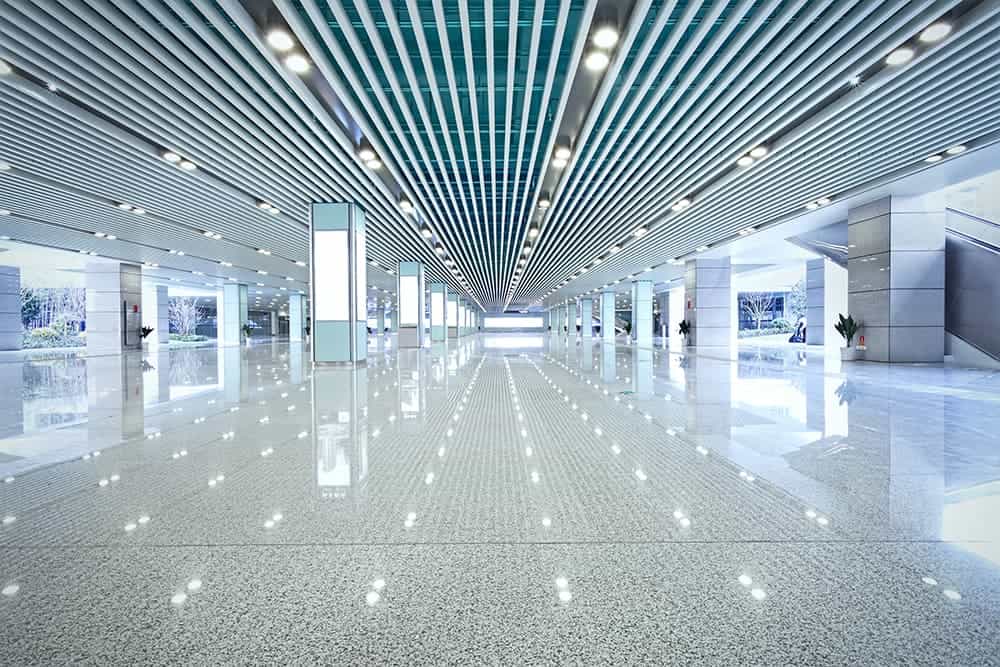
Factors To Consider For Commercial Lighting
When choosing Light fixtures for your commercial spaces, here are some factors that you should consider-
Ceiling Height
The ceiling height matters a lot while illuminating commercial lighting. If you have a high ceiling, go for hanging or suspended fixtures. Installing ceiling-attached lights may not be a good decision in this case. Instead use hanging bulbs, pendant lighting, or suspended LED lights.
For a DIY option, purchase aluminum channels and insert LED strips into it. Then hang them in a suspended method, and see how it works. It is an excellent idea for a high ceiling. Besides providing proper visibility, it also adds an aesthetic appearance to your space. However, for regular ceiling height, recessed lights, cove lighting with LED strips, regular tube light, or other regular lighting is enough.
Ceiling Type
Some ceilings need additional lighting treatment. For instance, concrete ceilings require suspended LED panel designs or surface mounts for LED panels. Again, insulation of the roof is an important factor when you install recessed lights.
You will need an IC-rated light fixture to use on insulated ceilings. If they are non-IC rated, there is a serious risk of a fire breakout. Check this article to know more about this- IC Vs. Non-IC Rated Recessed Light Fixtures.
Application Purpose
The type of lighting differs with the application purpose or where you are installing the light fixture. For example, some fixtures are ideal for restaurant lighting but not good for warehouses. So, it would be best to consider the lighting purpose before choosing any fixture. Here is a suggestion from my end-
| Commercial Area | Recommended Light Fixture |
| Offices | Tube Lights, LED Panels, Linear Suspension, Pendant Lighting, Troffers, LED Strips |
| Shopping Malls/ Retail Stores | LED Strips, Spotlights, Modular Linear Bar, Pendant Light, Recessed Lights |
| Restaurant & Hotels | LED strips, Recessed Lights, Lanterns, Pendant Lights, Chandeliers |
| Theatre & Museum | Spotlights, Track lights, LED Strips, Pendant Lights, Skyline Linear Light |
| Gas Station & Auto-Repair Shops | High Bay LED, Low Bay LED Lights, Tri-Proof Lights |
| Garages | Wraparound Fixtures, Canopy Lights, UFO High Bays, Shop Light |
| Outdoor | Flood Light, LED Neon Flex, Wall Packs, Wall Mount, Canopy, Wall Washer |
Beam Angle
The beam angle of the lighting determines how focused the light is in a particular direction. For low beam angles, light concentrates at a specific point. As you increase the beam angle, the light-spreading diameter increases gradually. Here distance plays a vital role. As the distance of the light fixture from the floor increases, the light spreading diameter also increases. The below chart will help you to get an idea of the output lighting for different beam angles-
| Beam Angle | Light Spreading Diameter | ||||
| 5 ft Ceiling | 8 ft Ceiling | 10 ft Ceiling | 12 ft Ceiling | 15 ft Ceiling | |
| 15 degree | 1.35’ | 2.16’ | 2.7’ | 3.24’ | 4.05’ |
| 25 degree | 2.25’ | 3.6’ | 4.5’ | 5.4’ | 6.75’ |
| 40 degree | 3.6’ | 5.76’ | 7.2’ | 8.64’ | 10.8’ |
| 120 degree | 10.8’ | 17.28’ | 21.6’ | 25.92’ | 32.4’ |
Required Brightness
The fixtures’ number, size, and spacing vary depending on the brightness. If you require high brightness, you can choose a few higher-lumen rating bulbs or numerous medium-lumen rated fixtures. You will need to increase the number of fixtures to get equal illumination from a high-power bulb. There are different brightness levels available for light fixtures that may confuse you. Here are some factors you should consider while determining the required brightness for your commercial space-
- Area of the space
- Availability of natural lighting
- Purpose of lighting (for accent lighting, higher brightness is required compared to ambient lighting)
- Desired light spacing
- Power consumption
However, another factor may trouble you while selecting the brightness of the light, which is different units of light property. If you don’t want to get into such a situation, read this article- Candela vs. Lux vs. Lumens.
Type Of Environment
You can use commercial lights for both indoor and outdoor use. And depending on this, the lighting requirements will vary. For instance, outdoor lighting requires more brightness than indoors. Again some light fixtures are specially designed for outdoor usage. Again, tri-proof lights are ideal for challenging environments where toxic chemicals or risk of exploration prevails. Similarly, there are many other safety lights like- water-proof, rust-proof, vapor-proof, explosion-proof, etc. So, first, consider the environment of the commercial zone, and select the lights accordingly.
Durability
Durability is a major factor for commercial lighting, as a frequent replacement can be a great headache for such installation. Suppose the billboard lights installed in a large commercial building require high cost. If the fixtures are not durable and need rapid replacement, you will be at a great loss. But how to check the durability of the fixture? No worries, consider the following points to select a durable light for your commercial space-
- The lifespan of the fixture
- Materials used for construction
- Certifications
- The reputation of the brand
- Compatibility with the application purpose
- Heat-dispersion system (check this to know how heat dispersion affects lights durability- LED Heat Sink: What Is It and Why It’s Important? )
Energy Consumption
Gas stations, pharmacies, and other emergency commercial services go through long shifts. Some run for all day in two shifts- day & night. Besides, in many other commercial sectors, lights are kept 24/7 for security. No doubt, it requires you to pay high electricity bills. To minimize these costs, choose energy-efficient commercial lighting. In this case, nothing can beat LED lights. You will be shocked that LED lights can produce the same lighting output using just 6-8 watts, whereas incandescent lights take up to 60 watts! So, if you want to save your pocket, go for LEDs.
CRI Rating
CRI stands for ‘Color Rendering Index’. It determines how accurate color the light can bring compared to natural lighting. It is crucial in selecting lighting for commercial areas like jewelry, barber shops, restaurants, etc. For instance, a bright red dress may appear pink due to low CRI-rated lighting. So, always go for higher CRI ratings. These are measured in 0 to 100 grades. Higher the rating, the better color accuracy it provides. CRI 100 shows the true color of an object. However, the lighting output of any rating above 90 is considered excellent.
IP & IK Rating
IP stands for ‘Ingress Progress’ and IK for ‘Impact Protection.’ These two ratings determine the robustness of the fixture against any outer interference. For instance, a higher IP rating means better protection against liquid and solid ingress. It prevents fixtures from adverse weather conditions like dust, storm, rain, etc. That is why outdoor lighting requires extensive protection; higher IP ratings. But how to know the degree of protection? No worries, this guide will help you- IP Rating: The Definitive Guide.
However, the Ik rating is graded from 00 to 10. Each rating has a specific protection level against impact, collision, hit, or other attacks. A higher IK rating is preferred as commercial areas are crowded and have frequent collisions. This guide will assist you in getting the ideal IK rating for your commercial lights- IK Rating: The Definitive Guide.
Color Temperature
The color of the lighting has a great impact on creating the right ambiance and influencing the human mind. Usually, white lights are classified into three different tones- warm, cool, and neural. Low color temperatures give yellowish tones, which are known as warm lights. In contrast, high color temperatures with bluish tones are called cool lights. And the light that gives off natural lighting is termed neural or daylight. In commercial lights, a cozy ambiance is essential; go for warm lights. For example- restaurants, hotels, resorts, spas, etc. Again cool lights are best for task lighting or activities that require focus. For instance, using warm lights in the office will make employees sleepy. In this case, cool lights suit best to keep them energetic and increase work productivity. Here are some recommendations for color temperature for different commercial applications-
| Commercial Area | Preferred Light Tone | Recommended Color Temperature In Kelvin |
| Office | Cool Tone | 3500K-5000K |
| Restaurant | Warm Tone | 2700K-3000K |
| Shopping Malls | Warm/Cool Tone | 3000K-5000K |
| Garage/Parking Lot | Cool Tone | 4000K-5000K |
| Warehouse | Cool Tone | 4000K-6500K |
However, if you want to use LED strips for lighting, this guide will help to select the ideal color temperature- How to Choose LED Strip Color Temperature?
Additional Features
Lights with additional features increase flexibility and greater user experience. You can adjust the ambiance of your space using these features. For instance, having motion sensor lights on your restaurant stairs will amaze the customers. It can be a major element in attracting customers to take your services. Again, choosing addressable/digital color-changing lighting is an excellent option for discos, concerts, parties, and other events. They can sync with music giving your audience the rie vibe to enjoy the music. Here are some features that you can consider for commercial lighting-
- Dimming capabilities
- Motion sensors
- Daylight harvesting
- Color tuning
- Occupancy sensors
- Remote control options
- Timer scheduling
- Smart home integration
- Emergency backup power
- Adjustable beam angles
Maintenance
Maintenance is a big factor when selecting commercial lighting. Residential lighting is easy to maintain, but it isn’t that easy for commercial areas. Upkeeping becomes difficult as these spaces are usually large and require numerous fixtures. That is why you should choose minimal maintenance fixtures; LED strips are ideal here.
Warranty
Warranty directly or indirectly indicates the quality of light fixtures. So, consider the warranty policies when you purchase lights for your commercial space. Usually, these lights have a warranty varying from three to five years. Besides, there are many other factors to consider. For instance, you must purchase the product from an authentic source. If the product is not originally manufactured, you will not get a refund or any free services. You should also be careful storing the memo or warranty card to get the warranty facilities.
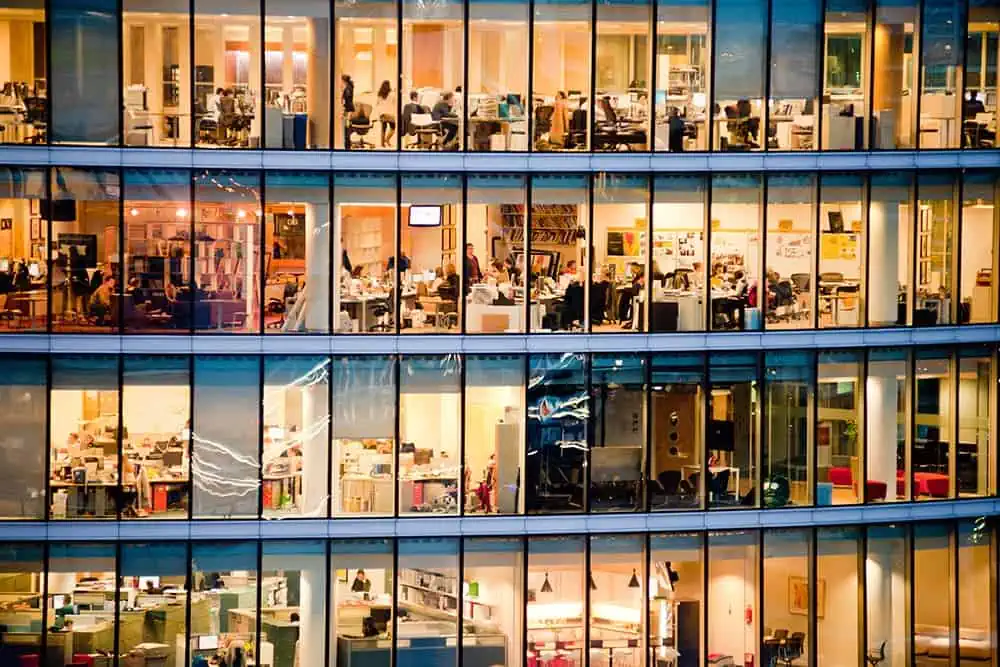
Health And Safety Standards For Commercial Lights
There are some codes that US commercial lighting requires to maintain. These ensure electrical safety, workplace safety, energy efficiency, and occupant well-being of commercial lighting.
- International Energy Conservation Code (IECC): IECC addresses all types of energy conservation aspects regarding both residential and commercial constructions. It focuses on using new energy-efficient standards, including lighting, heating, ventilation, and more. According to this code, outdoor lighting must be turned down at night depending on the occupancy time. After hours, the power of lights must be decreased by at least 50%!
- National Electric Code (NEC): Article 410 of the NEC covers all lighting standards for different applications. It includes lamp holders, lamps, and other ornamental lighting items. According to NEC, the unit load of different commercial lighting requires the following standard-
| General Lighting Areas (Commercial) | Unit Load (Volt-amperes/m2) |
| Warehouses | 3 |
| Garage/Halls, Corridors, Closets, Stairways | 6 |
| Armories and auditoriums | 11 |
| Hospital/Hotel/Motel/Restaurant/Courtrooms/Clubs | 22 |
| Barber Shops/Beauty Parlors/School/Stores | 33 |
| Office Buildings/Banks | 39b |
- American Society of Heating, Refrigerating, and Air-Conditioning Engineers (ASHRAE): ASHRAE provides commercial lighting standards such as ASHRAE/IES 90.1. This includes guidelines for energy-efficient lighting design, power & density limits, controls, daylighting integration, and quality criteria to promote energy savings and occupant comfort in commercial buildings.
- Occupational Safety and Health Administration (OSHA): OSHA has given some general lighting requirements for commercial areas. You must maintain these lighting requirements for safe and adequate illumination. These are as follows-
| Commercial Lighting Zones | Light Intensity |
| First-aid facilities, offices, and hospitals | 30 foot-candles |
| Businesses and general construction sites | 10 foot-candles |
| General construction area | 5 foot-candles |
| Warehousing areas, pathways, corridors, exits, and other indoor spaces | 5 foot-candles |
| Common underground work locations, such as shafts and tunnels | 5 foot-candles |
| Excavation sites, garbage disposal locations, loading docks, active storage spaces, field maintenance areas, and areas for fueling | 3 foot-candles |
Commercial Lighting Vs Industrial Lighting
Commercial and industrial are the two terms that you may often get confused about. Lighting for commercial areas and industrial areas is not the same. The below-differentiating chart will help you to know them better-
| Criteria | Commercial Lighting | Industrial Lighting |
| Definition | Commercial lighting is the lighting used in spaces where business and retail activities take place. | Industrial lighting is specifically designed for spaces where manufacturing, production, storage, and other industrial activities take place. |
| Purpose | It aims to create an inviting and pleasing environment for customers, clients, and employees. | It prioritizes safety, productivity, and efficient operations of industrial zones. |
| Application | Commercial lighting is commonly found in offices, retail stores, hotels, restaurants, shopping malls, and other similar spaces. | Industrial lighting is commonly used in warehouses, factories, production plants, workshops, logistics centers, and other industrial facilities. |
| Type Of Light Fixtures | Includes recessed lights, track lights, pendant lights, chandeliers, decorative wall sconces, and task lighting fixtures. | Includes high-bay lights, low-bay lights, strip lights, floodlights, area lights, etc. |
| Light Quality | Balances between functionality and visual appealProviding appropriate levels of brightness and color renderingEnhancing the beauty of the space | Achieving uniform lightingMinimizing shadowsProviding optimal visibility for tasks and safety. |
| Brightness | As commercial lighting aims to create a comfortable and relaxed atmosphere, they have lower brightness levels compared to industrial ones. | Industrial lighting typically requires higher brightness to ensure optimal visibility for tasks, machinery operation, and worker safety. |
| Safety Level | Regular safety ratings like high IP and IK ratings are enough for outdoor lighting. However, in some cases, water-proof, rust-proof, and explosion-proof fixtures are used. | As industrial lighting faces adverse areas that deal with the continuous impact, chemicals, and other hazardous conditions, they have a higher safety level than commercial lighting. |
Tips For Commercial lighting To Get Better Productivity
From the above discussions, you know all about choosing lighting for your commercial lighting. Now I’m presenting you some tips to get better productivity from commercial lighting-
- Consider natural light: For commercial areas like restaurants, schools, and offices, always prefer natural lighting. It creates a relaxing ambiance and saves your electricity bills daily.
- Implement proper task lighting: Working stations require adequate brightness. It can be your restaurant’s cooking station, office desk, or the space where you repair automobiles. Consider the area of the task zone and required brightness. Then select the fixture according to the requirements. Remember, having a suitable task light helps reduce eye strain and thus increases work productivity.
- Optimize lighting levels: Adequate lighting is crucial for productivity, but you should keep optimization levels in check. Consider energy-efficient lighting options to get maximum lighting output for less energy consumption. Besides, follow the international codes for lighting commercial space. It is a great reason to use dimmers and reduce the brightness of the lights at night.
- Choose lighting with the right color temperature: Color temperature greatly affects the ambiance of your commercial space. The requirement for lighting varies depending on your services or products. For example- if you want to light any jewelry shop, you must consider the type of jewelry. Gold jewelry requires a warm color temperature; white diamonds look best in cool light. (Check this to know all about jewelry shop lighting- How to Choose Lighting for Jewelry Stores?). So, whatever services you provide, research the color temperature and choose the one that suits your space best.
- Minimize glare and flicker: Having commercial lights that flier or cause direct glaring harms your service-providing image. Firstly the customers will not feel their best taking your services, second, the employees working will also not be able to provide better services. Besides, it also causes eye strain and headaches. So, be careful about these types of issues with commercial lighting. This article will guide you on handling issues with light fixtures- 29 Common Problems with LED Lighting.
- Incorporate circadian lighting: Installing cardiac lighting will help to increase the productivity of workers/employees in your commercial space. These lights mimic the natural light patterns to promote well-being and support a healthy work environment. And this positively impacts occupants’ mood, energy levels, and overall performance.
- Provide lighting control options: You should consider providing light-controlling options for individual sections. This will give the employees the best working environment. Controlling options may include- dimming, beam angle adjustability, color temperature customization, etc.
- Consider lighting maintenance: To keep your light on good terms for a longer period, keep the maintenance in check. However, commercial lighting does not require much maintenance. Yet here are some simple things that you can do-
- Clean them regularly to remove dust and dirt buildup.
- Replace burnt-out bulbs or damaged lighting fixtures.
- Conduct routine inspections to identify any lighting issues.
- Maintain proper wiring and connections to ensure reliable lighting functionality.
- Keep spare bulbs and components for quick replacements.
- Schedule periodic maintenance checks by qualified professionals.
- Train staff on basic maintenance tasks to address minor issues promptly.
- Stay updated with advancements in lighting technology for potential upgrades or improvements.
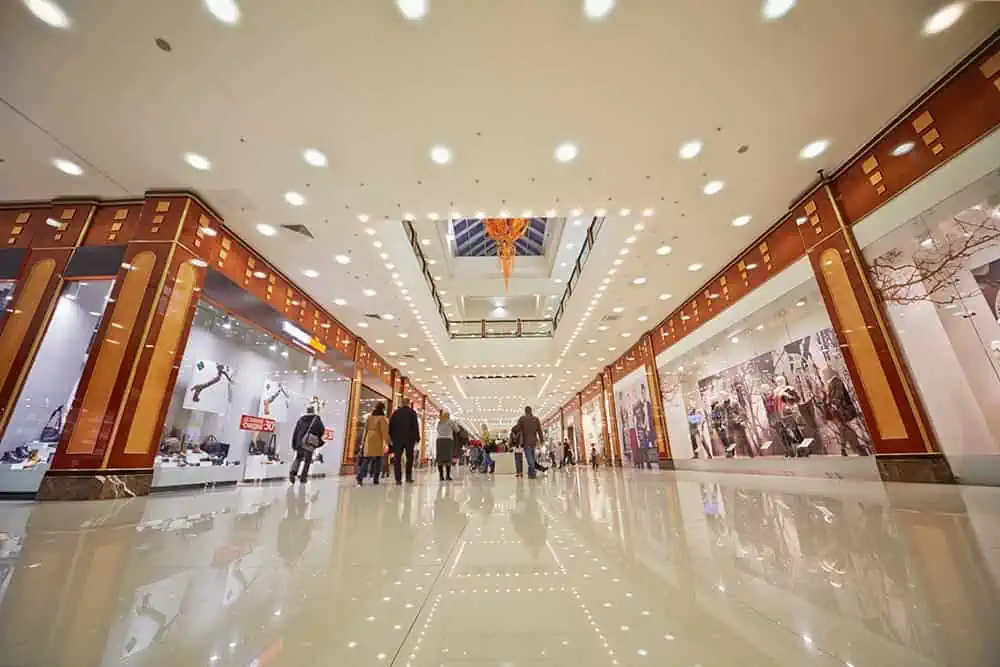
Emerging Trends & Technologies In Commercial Lighting
Lighting technology is bringing innovations in a continuous process. There is no doubt the upcoming advancement in lighting will provide better facilities for commercial lighting. Here are some of the major trends and technology that commercial lighting will bring in the coming days-
- Smart Lighting Systems: Smart Lighting is already on trend for commercial areas. For instance, you will find motion sensors on the stairs, pathways, hotel restaurants, shopping malls, etc. With the advancement of technology, smart lighting is going to be more common in every commercial aspect.
- Internet of Things (IoT) Integration: IoT enables interaction between lighting systems and other devices of commercial buildings. Implementing these technologies to your space will allow you centralized control, automation, and data-driven insights for efficient lighting management.
- Human-Centric Lighting: Human-centric lighting mimics natural light patterns to support well-being and productivity. It considers factors such as color temperature, intensity, and lighting spectrums that align with the body’s circadian rhythm. In the coming days, the use of these lights will be a trend to promote alertness, mood enhancement, and better productivity in commercial areas.
- LiDAR-Based Occupancy Sensing: Lighting systems incorporate LiDAR (Light Detection and Ranging) technology for precise occupancy sensing. These sensors employ lasers to detect motion and presence. It is one of the most emerging trends in commercial lighting, especially in the hospitality, healthcare, and entertainment sector. The advancement of LiDAR technology will enable more accurate and dependable lighting control based on real-time occupancy data.
- Advanced Energy-Efficient LED Lighting: LED lighting continues to advance in energy efficiency, longevity, and quality of light. In the near future, new LED technologies will offer enhanced energy savings, improved color rendering, and greater design flexibility.
- Augmented Reality (AR) Lighting Design: With augmented reality (AR), designers can overlay virtual lighting fixtures directly onto the real world. Designers can explore various fixtures, positions, and lighting effects. It also allows extensive customization and experimentation for commercial space. This gives them a live preview of how various lighting solutions will look in a commercial setting.
Top 6 Commercial Lighting Ideas
Want to outstand your commercial space with something innovative? Of course, you want to. To get you out of the boring, plain commercial lighting, I’ve got you six amazing lighting ideas that will take the appearance of your space to a next level!
Sculptural Lighting
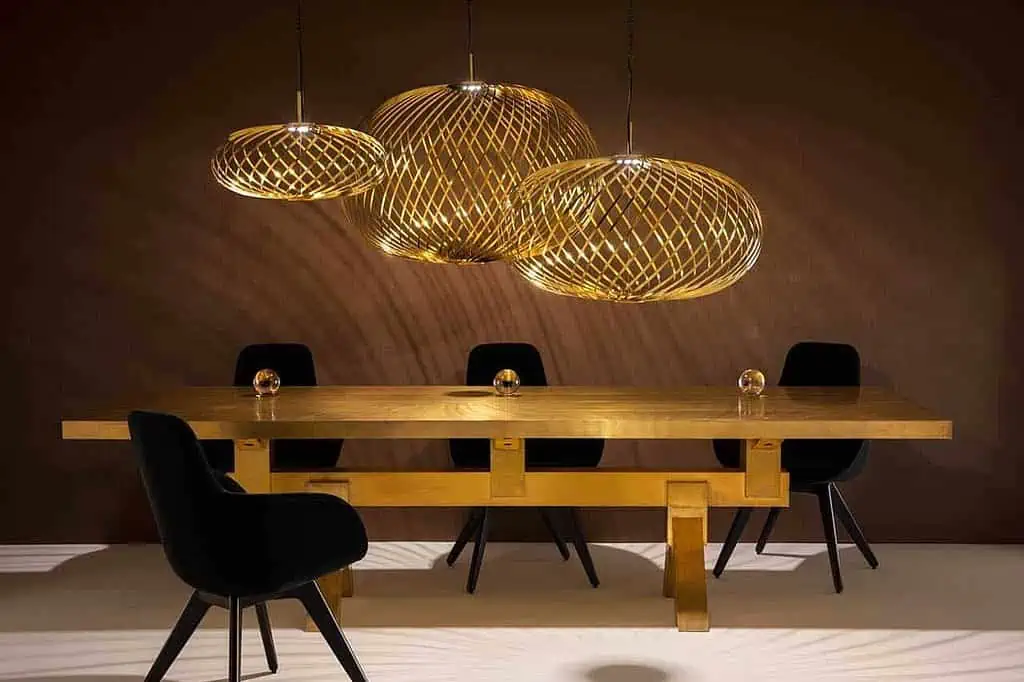
Instead of the plain ceiling fit lights, install sculptural fixtures in your commercial spaces to bring aesthetic ambiance. You can try lighting ideas for the office desk, conference room, restaurant table, or reception. Sculptural lighting will also look good in waiting rooms or lobbies. Consider the interior design to choose the structure of the light. You will find geometric-shaped pendant lightings to use here—besides, contact manufacturers to design the specific structure you plan to get. Trust me, adding such lights will change the entire outlook of your space.
Focal Point Lighting
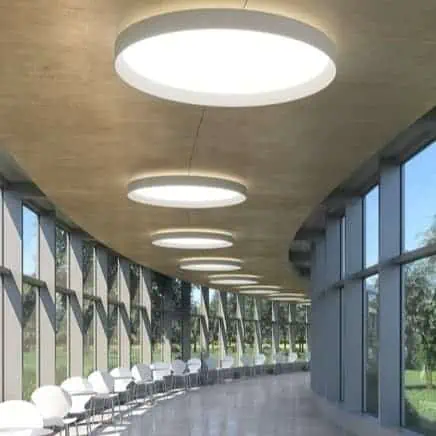
To light your commercial space’s corridor or walking areas, go for focal point lighting. All you need to do is target the center of the area and install lighting following the middle section. You will find different kinds of fixtures suitable for this purpose. Plane circular LED lights, semi-flush lights, or pot lights are ideal options here. Consider the interior designs and select fixtures accordingly. Designer panel lights or even large chandeliers may also be used in some cases. But you should be careful that whatever fixture you choose must match the area’s ambiance.
Geometric Lighting
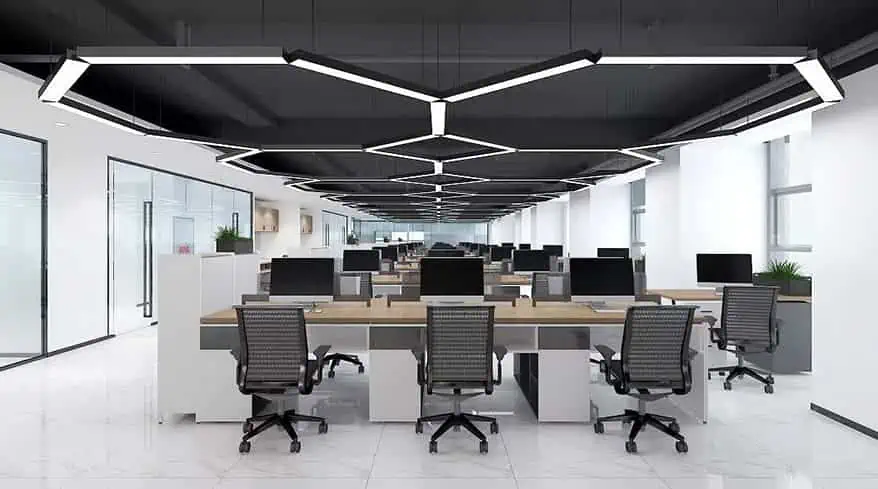
Bored of the dull ceiling lighting of commercial areas? Go for geometric lighting, but what’s that? The options in the design of LED lights are non-ending. You will find flat LED lights of any shape like- circle, oval, triangle, square, hexagonal, and more. Installing these geometric lightings in your office, showroom, restaurants, and halls will bring a fantastic outlook. You can also use DIY geometric lighting with LED strips or LED neon flex. These lights are super flexible; you can quickly size them and give them the desired shape!
Minimalist Lighting
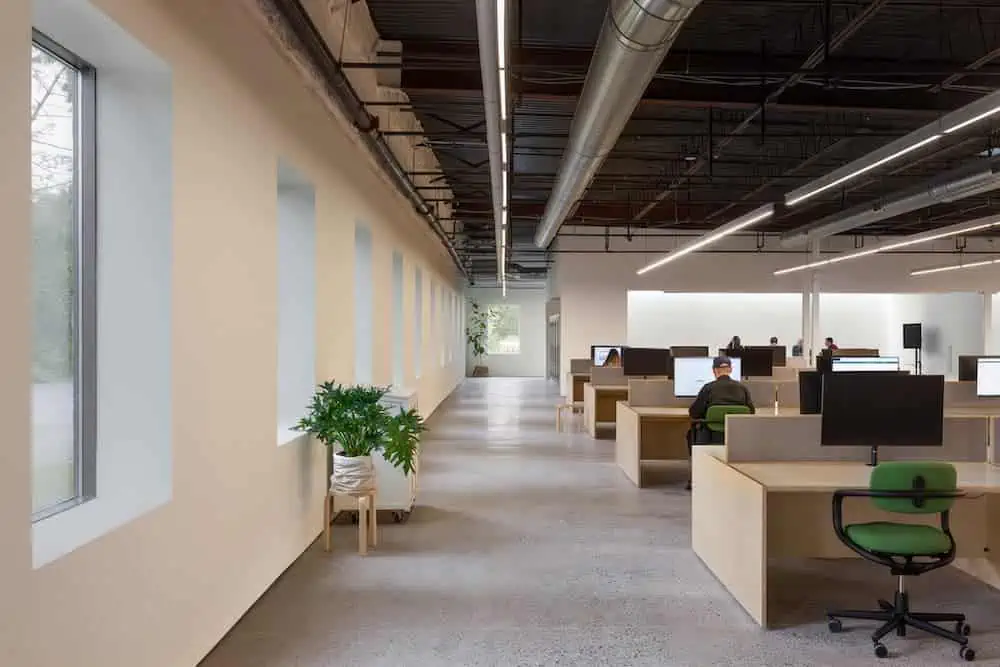
If you don’t want fancy lighting for your office or other commercial spaces, there are also minimalistic yet modern lighting options. However, LED tube lights are a traditional approach to minimalistic lighting options. But you can add a twist to it using LED strips. Mount the LED strips in a suspended technique using aluminum channels and see the outcome. You can choose the length of the strips according to your preference. The suspension of lighting will bring an artistic appearance without overdoing it. You can try such lighting for offices, warehouses, garages, or other commercial areas with high ceiling heights. However, you can also try other LED mounting methods instead of suspension. This guide will help you with mounting techniques of LED strips- Installing LED Flex Strips: Mounting Techniques.
Cove Lighting
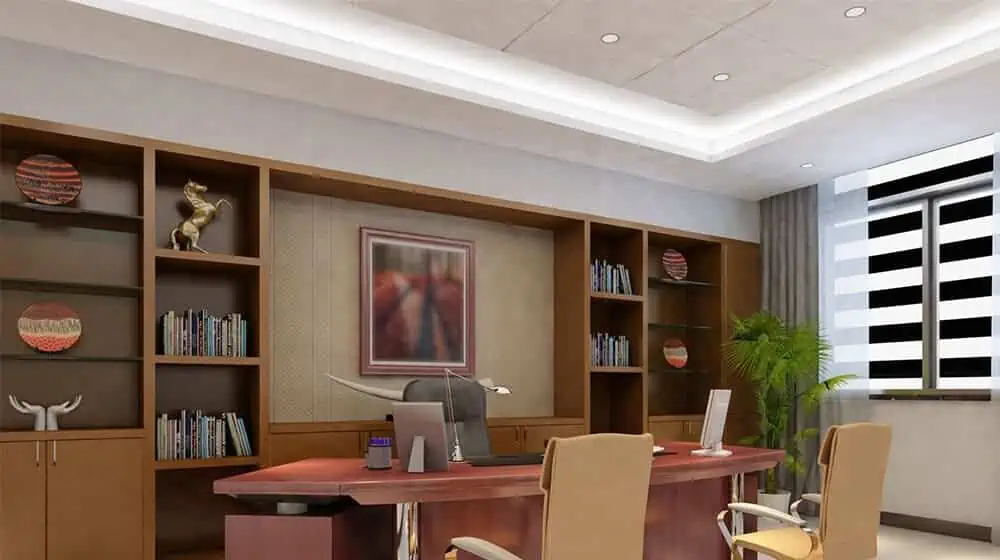
Cove lighting is the most modern approach for general lighting. It brings a modern and sleek outlook to your commercial space. In this type of lighting, you need to build a false ceiling and insert LED strip lights along the inner part of the ceiling. This creates an indirect/hidden lighting effect. This not only brings a sophisticated look but also removes direct light glares. You can use light lighting for your office, hotel lounge, waiting rooms, reception, etc. Besides, the recessed and LED cove lighting combination is an excellent match. However, you can use LED neon flex instead of LED strips for cove lighting commercial spaces like – automobile showrooms, bars, or pubs. This will bring an electrifying look to complement the ambiance.
Logo Lighting
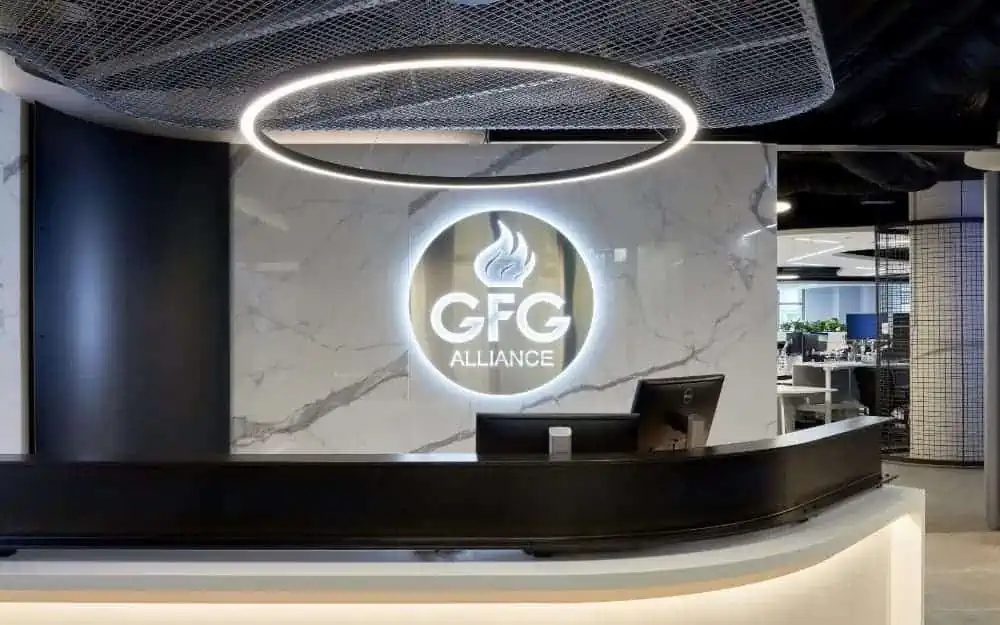
The logo or brand name is essential to any commercial space. It can be your office name, restaurant logo, and outlet logo. You can use track lights and spotlights to highlight your business logo. But the most promising option is going for LED neon signage. Glass Neon Lights vs. LED Neon Lights has been popular for logo lighting for ages, but LED signage is a more affordable and efficient approach. You can make your own business logos using LED neon flex. These super flexible lightings are bendable, which helps you to structure them in different shapes. There are vertical bending, horizontal bending, 360-degree bending, and more options in neon flex. So, get them and design your business logo- How to Make a DIY LED Neon Sign.
FAQs
LED lights are best for commercial use. In comparison to traditional lighting, they consume about 85% less energy. This makes them an ideal option for commercial usage. Besides, they are durable and have advanced features that can make your business attractive to the customer.
Commercial lighting ensures visibility and impacts the reputation of the business or services. You can use lighting for branding and marketing, such as neon signage outside outlets. However, the requirement for commercial lighting is different from the residential ones. As these spaces face more risk of impact and ingress, you should always purchase commercial-grade lighting for better protection.
Commercial lighting is designed to illuminate business and public spaces like office restaurants, shops, etc. In contrast, residential lights are manufactured for homes to bring a warm and comfortable ambiance. Besides, commercial lights have higher resistance levels and better safety features. But as residential lighting does not face much averse environment, they are built not as robust as commercial ones.
LED lighting brings numerous benefits to commercial lighting in comparison to other lighting. Firstly, they don’t produce any harmful gas like halogen bulbs. Maintaining these fixtures is very quick and simple; they don’t require frequent repair or replacement. LED lights are super durable and can last for 50,000 to 100,000 hours. Above all, they are highly energy efficient and give you smart lighting options. So, with LED, you get all the benefits of spending less on electricity bills.
By choosing energy-efficient bulbs, you can minimize the cost of commercial lighting. In this case, nothing can beat LED lights as they are highly energy-efficient. Apart from this, durability, lifespan, warranty, quality, and manufacturing brand are the essential considerations. Installing a premium-quality bulb will save you the cost of frequent repair and replacement. Purchasing bulbs with higher lumen, IK, or IP ratings more than your needs is nothing but a waste of money. So, knowing your lighting requirements is equally essential. You should also keep practicing some basic usage tips, like- dimming the lighting at night and maintaining other commercial lighting codes.
The lifespan of commercial lighting depends on the type of light you use. Incandescent lights can last for 1000 hours, and fluorescent lights for 15,000 hours. The best option here is LED lights; they last for 50,000 hours+. And with proper maintenance, you can use them longer.
The Bottom Line
When choosing lighting for your commercial space, list your requirements. All commercial areas don’t need the same lighting qualities. For instance, hospital lighting will differ from restaurant lighting. So, calculate the required lumen rating, type of fixture, number of bulbs, suitable color temperatures, etc. You should also consider the environment of the space to determine the IP and IK ratings.
Therefore, you will find vast options on light fixtures for commercial areas. These include- spotlights, tube lights, high-bay/low-bay lights, LED strips, neon lights, and more. If you are planning to get LED strips or LED neon lights, LEDYi should be your best option. Our products are lab-tested and highly fit for commercial usage. You can use our LED strips to light your office, restaurant, salon, shopping mall, or other retail stores. Again, go for our super flexible neon flex lights to illuminate your brand logo. So, contact us soon to get the best lighting output from your commercial space.
